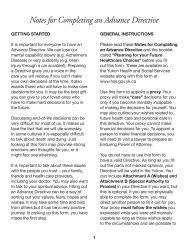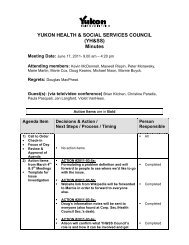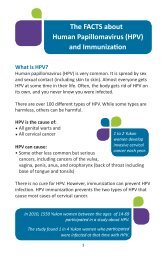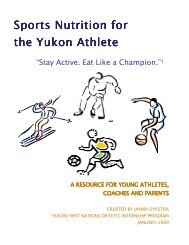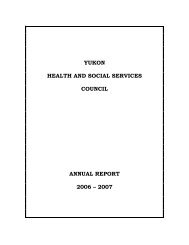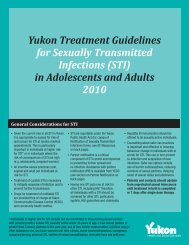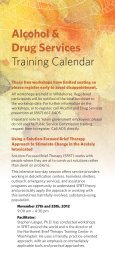Principles of Immunology - Health and Social Services
Principles of Immunology - Health and Social Services
Principles of Immunology - Health and Social Services
Create successful ePaper yourself
Turn your PDF publications into a flip-book with our unique Google optimized e-Paper software.
Community Nursing<br />
Yukon Immunization Program<br />
Section 14 - <strong>Principles</strong> <strong>of</strong> <strong>Immunology</strong><br />
2011 March<br />
Page 2<br />
The lymphatic vessels closely parallel the body’s veins <strong>and</strong> arteries. Lymph nodes are<br />
found throughout the lymphatic vessels <strong>and</strong> provide meeting areas for interaction<br />
between the immune system cells.<br />
The lymphatic system contains the following:<br />
Primary lymphoid organs<br />
Bone marrow<br />
Thymus<br />
Lymphatic vessels<br />
Figure 2 - Lymphatic System<br />
Secondary lymphoid organs<br />
Spleen<br />
Lymph nodes<br />
1.4 TYPES OF IMMUNITY (SEE FIGURE 3)<br />
Passive Immunity:<br />
Antibodies from another person or animal that can be injected or transfused.<br />
Called passive because the individual did not create the antibodies, but instead<br />
received pre-formed antibodies.<br />
Protection is effective, but duration is short lived <strong>and</strong> no memory is created.<br />
Examples <strong>of</strong> passive immunity are maternal antibodies (trans-placental <strong>and</strong> breast<br />
milk) <strong>and</strong> injected antibodies (e.g., rabies, varicella, <strong>and</strong> tetanus immune globulins).<br />
Active Immunity:<br />
When the body is exposed to a foreign substance the cells <strong>of</strong> the immune system<br />
“actively” respond. Active immunity is further divided into categories:<br />
Innate Immunity - protective mechanisms we are born with<br />
Adaptive Immunity – cell mediated immunity <strong>and</strong> humoral immunity




![Women and Alcohol: A women's health resource [2326.26 KB ]](https://img.yumpu.com/22340649/1/190x245/women-and-alcohol-a-womens-health-resource-232626-kb-.jpg?quality=85)
